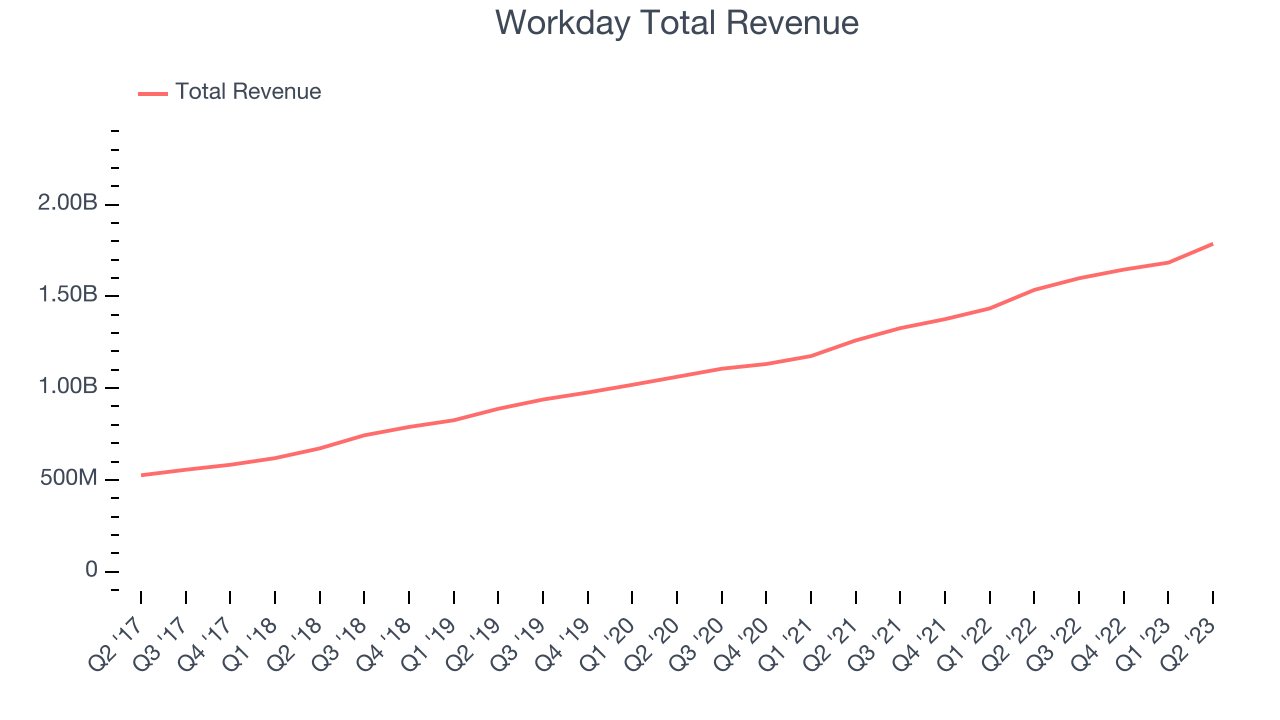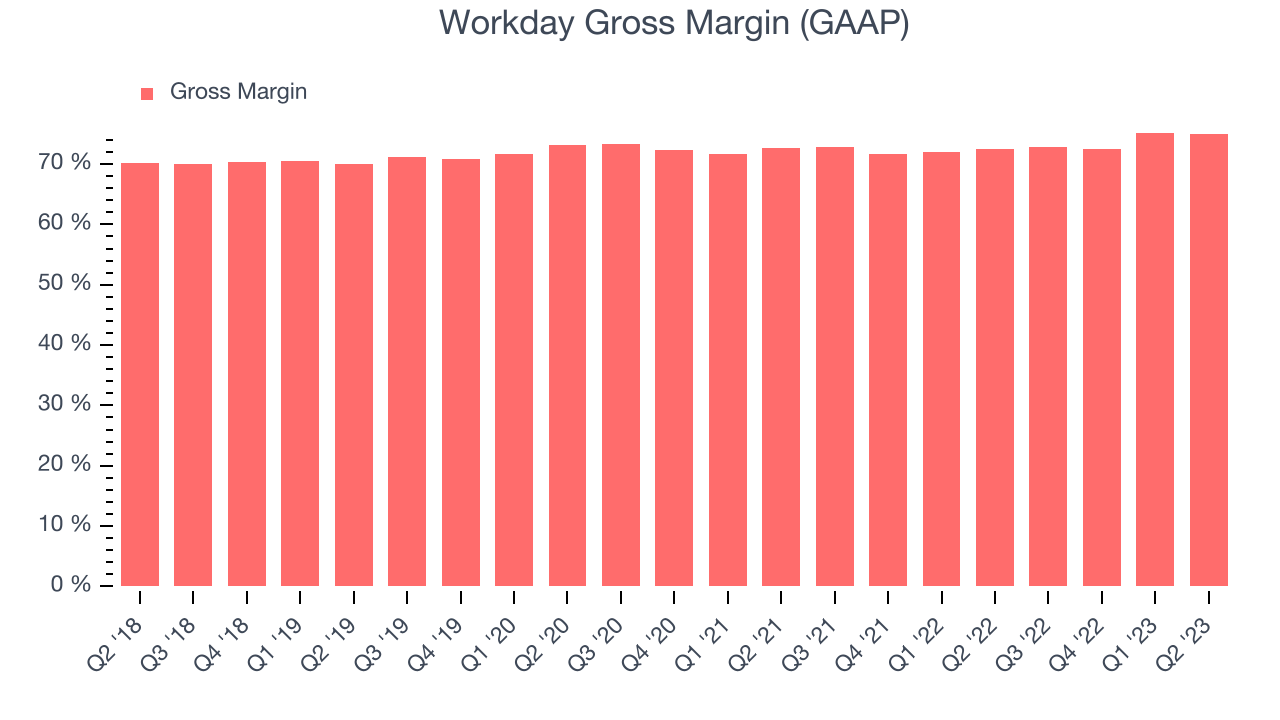Finance and HR software company Workday (NASDAQ:WDAY) reported results in line with analysts' expectations in Q2 FY2024, with revenue up 16.3% year on year to $1.79 billion. The company also slightly raised its full-year subscription services revenue and adjusted operating margin guidance. Workday made a GAAP profit of $78.7 million, improving from its loss of $64.2 million in the same quarter last year.
Is now the time to buy Workday? Find out by accessing our full research report, it's free.
Workday (WDAY) Q2 FY2024 Highlights:
- Revenue: $1.79 billion vs analyst estimates of $1.77 billion (small beat)
- EPS (non-GAAP): $1.43 vs analyst estimates of $1.26 (13.6% beat)
- Free Cash Flow of $361.5 million, up 65.4% from the previous quarter
- Gross Margin (GAAP): 74.9%, up from 72.5% in the same quarter last year
"Workday delivered another strong quarter, driven by our ongoing focus on employees, customers, and innovation – including our leadership in AI and ML," said Aneel Bhusri, co-founder, co-CEO, and chair, Workday. "We're seeing continued momentum with more than 3,000 customers sharing their data with our ML models, more than 50 million ML inferences processed per day, and multiple generative AI capabilities in development including several that we plan to unveil next month at Workday Rising. We believe this momentum will continue to grow as more companies look to Workday as their trusted partner in responsible implementation of AI and ML".
Founded by industry veterans Aneel Bushri and Dave Duffield after their former company PeopleSoft was acquired by Oracle in a hostile takeover, Workday (NASDAQ:WDAY) provides cloud-based software for organizations to manage and plan finance and human resources.
Finance and accounting software benefits from dual trends around costs savings and ease of use. First is the SaaS-ification of businesses, large and small, who much prefer the flexibility of cloud-based, web-browser delivered software paid for on a subscription basis than the hassle and expense of purchasing and managing on-premise enterprise software. Second is the consumerization of business software, whereby multiple standalone processes like supply chain and tax management are aggregated into a single, easy to use platforms.
Sales Growth
As you can see below, Workday's revenue growth has been solid over the last two years, growing from $1.26 billion in Q2 FY2022 to $1.79 billion this quarter.

This quarter, Workday's quarterly revenue was once again up 16.3% year on year. We can see that Workday's revenue increased by $102.5 million quarter on quarter, which is a solid improvement from the $38.1 million increase in Q1 2024. Shareholders should applaud the acceleration of growth.
Looking ahead, analysts covering the company were expecting sales to grow 16% over the next 12 months before the earnings results announcement.
While most things went back to how they were before the pandemic, a few consumer habits fundamentally changed. One founder-led company is benefiting massively from this shift and is set to beat the market for years to come. The business has grown astonishingly fast, with 40%+ free cash flow margins, and its fundamentals are undoubtedly best-in-class. Still, its total addressable market is so big that the company has room to grow many times in size. You can find it on our platform for free.
Profitability
What makes the software as a service business so attractive is that once the software is developed, it typically shouldn't cost much to provide it as an ongoing service to customers. Workday's gross profit margin, an important metric measuring how much money there's left after paying for servers, licenses, technical support, and other necessary running expenses, was 74.9% in Q2.

That means that for every $1 in revenue the company had $0.75 left to spend on developing new products, sales and marketing, and general administrative overhead. Trending up over the last year, Workday's gross margin is around the average of a typical SaaS businesses. Gross margin has a major impact on a company’s ability to develop new products and invest in marketing, which may ultimately determine the winner in a competitive market. This makes it a critical metric to track for the long-term investor.
Key Takeaways from Workday's Q2 Results
With a market capitalization of $60 billion, a $6.66 billion cash balance, and positive free cash flow over the last 12 months, we're confident that Workday has the resources needed to pursue a high-growth business strategy.
It was good to see Workday beat analysts' EPS and free cash flow estimates by a wide margin this quarter. We also enjoyed seeing it lift its full-year revenue and adjusted operating margin guidance, driven by higher expectations for subscription services revenue. Zooming out, we think this was a decent quarter, showing that the company is staying on target. The stock is up 3.18% after reporting and currently trades at $232.36 per share.
So should you invest in Workday right now? When making that decision, it's important to consider its valuation, business qualities, as well as what has happened in the latest quarter. We cover that in our actionable full research report which you can read here, it's free.
One way to find opportunities in the market is to watch for generational shifts in the economy. Almost every company is slowly finding itself becoming a technology company and facing cybersecurity risks and as a result, the demand for cloud-native cybersecurity is skyrocketing. This company is leading a massive technological shift in the industry and with revenue growth of 50% year on year and best-in-class SaaS metrics it should definitely be on your radar.
The author has no position in any of the stocks mentioned in this report.
